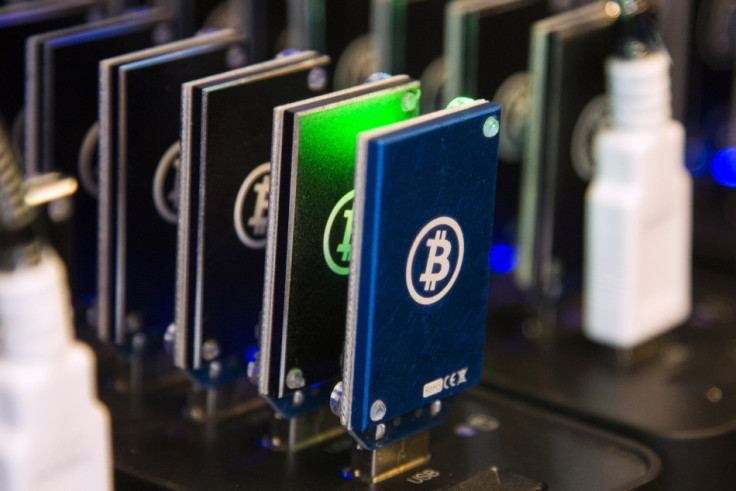Bitcoin Miners Cash in on Digital Gold Rush
The recent bitcoin boom has not just earned money for traders - miners extracting the virtual currency by using powerful computers to solve mathematical equations have also been cashing in.

Searching Google for "bitcoin mining computer" returns a terrifying blend of Frankenstein-like contraptions: tangled cables spread across a bedroom floor; hundreds of graphics cards being worked to within an inch of their life; huge fans desperately trying to stop the whole thing from melting.
As the value of bitcoin surged past the $300, then $400, barrier earlier this month, the get-rich-quick bandwagon propelled by the mysterious virtual currency was not just causing a boom in trading, but also in mining.
- Read more: What is bitcoin and how does it work?
It is said that during a gold rush, the real money is in selling shovels. As bitcoin's value soars, crudely connected graphics cards are the shovels of the 21st century, and while much of the excitement surrounding bitcoin this year has focused on the trading (and theft) of the coins, little attention has been given to another booming industry brought to life by users looking to make their money from being a step further up the foodchain.
Mathematical equations
Bitcoins are mined by computers, which use their processing power to solve mathematical equations. Once solved, a batch of coins is released and given to the owners of the computers used to mine them, who often work together to speed up the process. These equations automatically get more difficult as coins are mined. Of the 21 million bitcoins that can ever be mined, 11.9 million are currently in circulation.
Back in 2009, when bitcoin was new and each coin was worth less than one cent, anyone could mine using their own computer. But as the number of mined bitcoins grew, so did the difficulty of the mathematical equations. This slowed down the process - to stop inflation - and prompted miners to use more powerful computers.
Now, as bitcoins pass $400 apiece, entrepreneurs have jumped on the opportunity of selling dedicated bitcoin-mining computer rigs. One such company, Sweden-based KnCMiner, made $3 million (£1.9m) in revenue in just four days between 7 and 10 November.

Virtual gold rush
Founded in April - when bitcoin's value soared to $266, before crashing by 50% in a matter of hours - KnCMiner has now completely sold out of mining equipment, overcome by what it calls a "virtual gold rush".
Its chief executive, Andreas Kennemar, told The Register: "In four short days, we pushed $3m of equipment out the door. The increased activity around bitcoin in just half a week undoubtedly had a sizable impact on our sales.
"We're now focusing on doing everything we can to meet the demand we expect we will continue to receive, especially as bitcoin's popularity continues to soar."
Since opening for business seven months ago, the company has sold $29m worth of mining equipment to customers in 120 countries; in all, more than 5,000 mining machines have been sold.
According to a chart produced by the official bitcoin wiki page, mining equipment can cost between $140 and almost $30,000, with the speed at which they can mine coins increasing accordingly.
However, readers thinking they can make a quick buck through bitcoin mining should exercise caution. Making a profit from mining involves carefully weighing up the initial cost of buying the equipment - essentially rows and rows of graphics cards - the time they take to mine each coin and the cost to provide their electricity, against the value of coins produced.
The more money spent up front, the quicker bitcoins will be mined, and the quicker they are mined, the sooner the upfront cost is recovered and a profit is made. With bitcoin's value growing from less than $25 to more than $430 in 11 months, the demand for mining machines will only go one way.
Cloud mining
An alternative to buying your own mining hardware is to pay for a company like UK-based Cloud Hashing to do the hard work for you. Prices start at $276 per year, and although this method saves you from buying and running your own mines, the value of each bitcoin you earn will be less, as Cloud Hashing takes a cut to cover its costs and make a profit.
Printing money
With the value of bitcoin rising every day, either mining method seems like a license to print money - but the currency has crashed dramatically before and there's no reason why it could not do the same again.
Investing in bitcoin - whether by buying coins or mining them - will always be fraught with risk. But if you're willing to take a gamble, buying and selling these digital shovels could be where the real money is made.
Read More: Is Aother Bitcoin Bubble About to Bust as Value Soars Past $300?
© Copyright IBTimes 2025. All rights reserved.






















